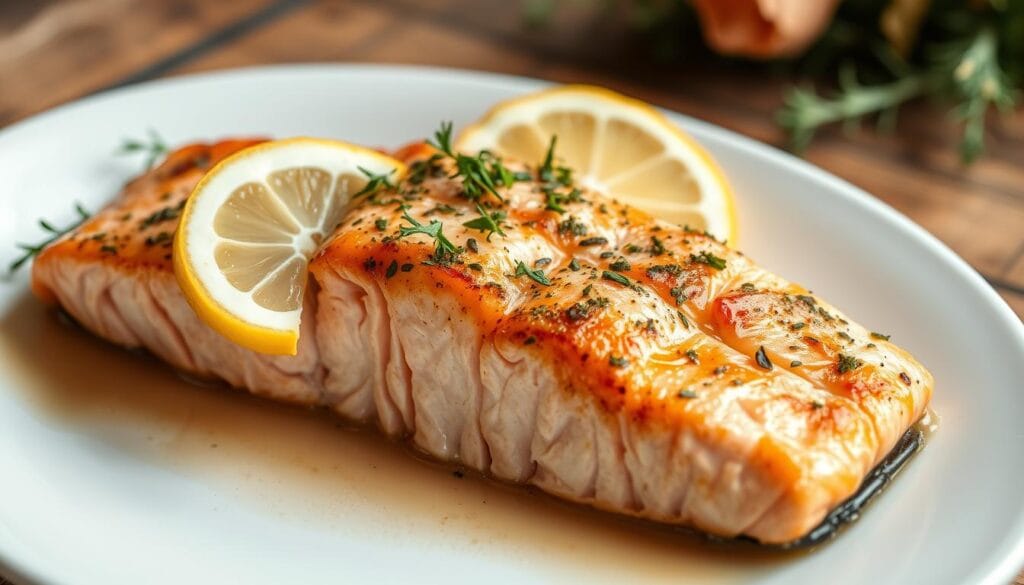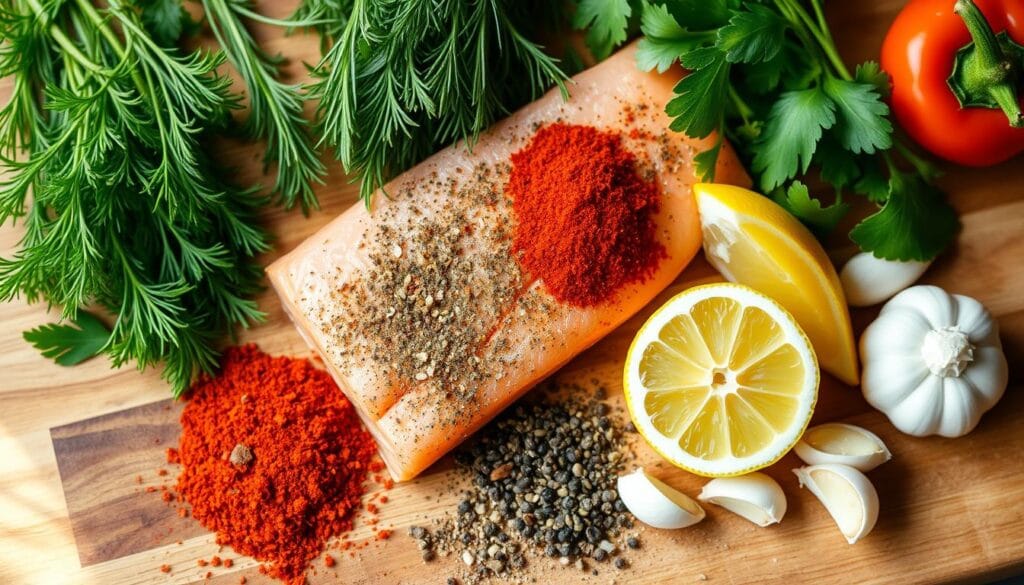The smell of baked salmon is fantastic. I’ve worked hard as a home cook to make it tender and tasty. Today, I’ll share how to cook salmon perfectly every time, with fresh or frozen fillets.
Knowing how to bake salmon is crucial for a quick lunch or a big event. This guide will show you how to bake salmon at 400°F. Your fillets will be moist, flaky, and full of flavor.
Table of Contents
Understanding the Basics of Salmon Preparation
Preparing salmon is easy and rewarding. You can use fresh or frozen salmon. Knowing the different cuts and having the right tools is key to cooking it right.
Different Types of Salmon Cuts
Salmon can be cooked as whole fillets or individual pieces. Whole fillets look great, but individual cuts are quicker and easier to manage.
Fresh vs. Frozen Salmon
Fresh salmon is better in color, texture, and taste. However, frozen salmon is cheaper and better if it is thall before cooking.
Essential Kitchen Tools for Baking Salmon
- Baking sheet or sheet pan
- Parchment paper or silicone baking mat
- Instant-read digital thermometer
These tools ensure your salmon is cooked perfectly. They help with temperature and prevent sticking or overcooking.
Learning the basics of salmon preparation will help you make tasty salmon dishes at home.
The Perfect Temperature for Baking Salmon
The correct temperature is key to baking moist and tasty salmon. The FDA recommends cooking salmon at 145°F, which can make the fish dry and tough. It’s better to remove it from the oven at 135°F.
Cook’s Illustrated suggests cooking farmed salmon to 125°F and wild salmon to 120°F. The salmon should be removed at 135°F to rest. This way, it reaches the perfect 145°F inside, making it tender and flavorful.
| Salmon Type | Ideal Internal Temperature |
|---|---|
| Farmed Salmon | 125°F |
| Wild Salmon | 120°F |
Using an instant-read thermometer is crucial. It helps you get the salmon baking temperature right, avoiding overcooking and ensuring the perfect texture and flavor every time.
How Long to Cook Salmon at 400
Baking salmon at 400°F can take different times based on the fish’s cut and thickness. Knowing the correct cooking time is key whether you’re baking fillets or a whole side. This ensures the salmon turns out tender and flaky.
Cooking Time for Individual Fillets
Bake 6-ounce salmon fillets at 400°F for 11 to 14 minutes. This time, it helps the salmon cook evenly, moi, and flavorful.
Cooking Time for Whole Side of Salmon
A 1 3/4-pound side of salmon takes longer to bake, about 15 to 18 minutes at 400°F. This extra time ensures the salmon cooks well from edge to center.
Adjusting Time for Thickness
- Thicker salmon fillets or steaks need more time, while thinner ones cook faster.
- Check the salmon’s internal temperature with an instant-read thermometer. For medium-rare to medium-rare, aim for 135°F to 140°F.
- Press the top of the fillet with your finger to check if it’s done. It should flake easily when cooked.
Watch the fish closely for perfect salmon cooking time, and bake the salmon at 400. Adjust the cooking time based on thickness and your desired doneness.
Essential Tips for Moist and Flaky Salmon
Getting moist and flaky salmon right is an art. But with a few tips, you can make salmon dishes like a pro. The secret is in the timing and technique.
First, don’t overcook your salmon. Moist salmon is what you want, not dry fish. Baking in foil or parchment paper helps keep it moist. It traps moisture and prevents drying.
For flakiness, choose thicker fillets or a whole side of salmon. Fattier salmon, such as sockeye or coho, is also more moist.
Try stuffing your salmon with lemon slices, herbs, or creamy sauce. This adds moisture and flavor. You can also wrap it in puff pastry for a moist and flaky treat.
Finally, use a sauce or glaze to enhance your salmon cooking tips. A tasty sauce can hide any dryness and add moisture.
“The secret to perfectly cooked salmon is all about finding the sweet spot between underdone and overcooked. With a little practice and these helpful tips, you’ll be serving up moist, flaky salmon that will impress your family and friends.”

Signs of Perfectly Cooked Salmon
Getting your salmon fillet just right can be tricky. But with a few easy steps, you can get it perfect every time. You can use a meat thermometer or look at the fish to see if it’s done. Here are the key signs of salmon doneness.
Using a Meat Thermometer
The best way to check your salmon’s doneness is to use an instant-read thermometer. Insert the thermometer into the thickest part of the fillet, but not the bone. The FDA recommends a temperature of 145°F for perfectly cooked salmon.
Visual Indicators of Doneness
You can also tell if your salmon is done by looking at it. When you press it with a fork, the flesh should flake easily, and the center should no longer look raw or explicit.
Texture Testing Methods
The best perfectly cooked salmon is flaky and moist, not dry or stiff. Press the fish gently with your finger. It should feel slightly firm but still soft and juicy. Don’t overcook it, or it will be dry and tough.
By using these methods together, you can always get perfectly cooked salmon. It will be moist, flavorful, and just right for you.
Seasoning Options and Flavor Combinations
Choosing the righpropersoning caenhancest the taste of baked salmon. You can salt and pepper and experiment with something more adventurous. There are countless ways to elevate your salmon dish.
Salt and pepper are classic choices. They let the salmon’s natural taste shine while adding warmth. Adding paprika or garlic powder can give it an extra kick.
For a citrusy twist, mix lemon and orange zest with olive oil. Or, try a dry rub with brown sugar, salt, paprika, and garlic for a sweet and savory crust.
Fresh herbs like cilantro and parsley can add a fresh, herbaceous flavor to salmon. Pairing them with a mustard-based seasoning adds depth to the dish.
| Seasoning | Flavor Profile |
|---|---|
| Salt and Pepper | Classic, enhances natural salmon flavor |
| Lemon and Orange Zest | Bright, citrusy, and refreshing |
| Brown Sugar Dry Rub | Sweet, savory, and caramelized |
| Mustard and Herb Blend | Tangy, herbaceous, and complex |
Remember, the secret to greatexcellenton seasoning is to try new flavors. Experiment with different salmon seasoning and salmon flavor combinations to find what you like best. Have fun exploring!

Cooking Methods: With and Without Foil
There are two main ways to bake salmon: in foil or on a sheet pan. Both methods can make delicious salmon but differ in texture and recipe requirements.
Benefits of Foil Wrapping
Cooking salmon in foil keeps it moist and prevents drying. The foil steams the salmon, making it tender and juicy. The flavors infuse into the fish, making it perfect for adding sauces or marinades.
Open-Pan Baking Technique
Baking salmon without foil gives a crispy top. This method is excellent for crispy surfaces. Use parchment paper or a silicone mat on your baking sheet to avoid sticking.
Foil-wrapped and open-pan baking is excellent for salmon and baking without foil. Choose what fits your recipe and taste preferences.
Common Mistakes to Avoid When Baking Salmon
Baking salmon is a great way to enjoy a healthy meal. But, it’s key to avoid common mistakes. Salmon baking mistakes and overcooking salmon are significant issues for home cooks.
One big mistake is overcooking the salmon. It’s best when cooked to medium, with an internal temperature of about 135°F. Cooking it too long, like too well-done (145°F or more), makes it dry and tough.
- Avoid cooking salmon to be well-done, leading to a dry, toughruggedure.
- Use a meat thermometer to ensure the salmon reaches the ideal internal temperature of 135°F for medium doneness.
- Let the salmon rest for a few minutes after baking to allow the juices to redistribute, preventing it from drying out.
Another mistake is not considering the thickness of salmon fillets or the whole side. Even cooking is key. Thicker pieces need more time in the oven than thinner ones. Adjust the baking time to avoid overcooking salmon in some spots and undercooking in others.
You can make moist, tasty salmon every time by watching out for these common mistakes. You’ll impress your loved ones with a bit of care with perfect salmon dishes.
Conclusion
Baking salmon at 400°F is the secret to a perfect salmon bake every time. Follow the cooking times and internal temperature guidelines for moist, flaky salmon. Try different seasonings and cooking methods to find your favorite way to bake salmon.
Using an instant-read thermometer is key to perfect salmon. Aim for an internal temperature of 135°F before resting. The size and thickness of your salmon will affect cooking time, so adjust accordingly.
With these tips, you’ll master baking salmon at 400°F. Then, you can enjoy delicious, restaurant-quality salmon in your kitchen. Bon appétit!
FAQ
What is the perfect temperature to bake salmon?
How long should I bake salmon at 400°F?
What internal temperature should salmon reach when fully cooked?
How should I prepare salmon for baking?
What is the recommended cooking temperature for salmon?
How long should I bake individual salmon fillets and a whole side of salmon at 400°F?
What tips can I use to ensure moist and flavorful salmon?
How can I tell when salmon is perfectly cooked?
What are some popular seasoning options for baked salmon?
Should I bake salmon with or without foil?
What are some common mistakes to avoid when baking salmon?
Have you tried our Recipe ?
There are no reviews yet. Be the first one to write one.

